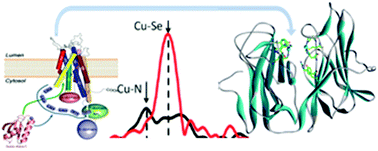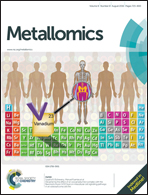pH-regulated metal–ligand switching in the HM loop of ATP7A: a new paradigm for metal transfer chemistry†
Abstract
Cuproproteins such as PHM and DBM mature in late endosomal vesicles of the mammalian secretory pathway where changes in vesicle pH are employed for sorting and post-translational processing. Colocation with the P1B-type ATPase ATP7A suggests that the latter is the source of copper and supports a mechanism where selectivity in metal transfer is achieved by spatial colocation of partner proteins in their specific organelles or vesicles. In previous work we have suggested that a lumenal loop sequence located between trans-membrane helices TM1 and TM2 of the ATPase, and containing five histidines and four methionines, acts as an organelle-specific chaperone for metallation of the cuproproteins. The hypothesis posits that the pH of the vesicle regulates copper ligation and loop conformation via a mechanism which involves His to Met ligand switching induced by histidine protonation. Here we report the effect of pH on the HM loop copper coordination using X-ray absorption spectroscopy (XAS), and show via selenium substitution of the Met residues that the HM loop undergoes similar conformational switching to that found earlier for its partner PHM. We hypothesize that in the absence of specific chaperones, HM motifs provide a template for building a flexible, pH-sensitive transfer site whose structure and function can be regulated to accommodate the different active site structural elements and pH environments of its partner proteins.



 Please wait while we load your content...
Please wait while we load your content...